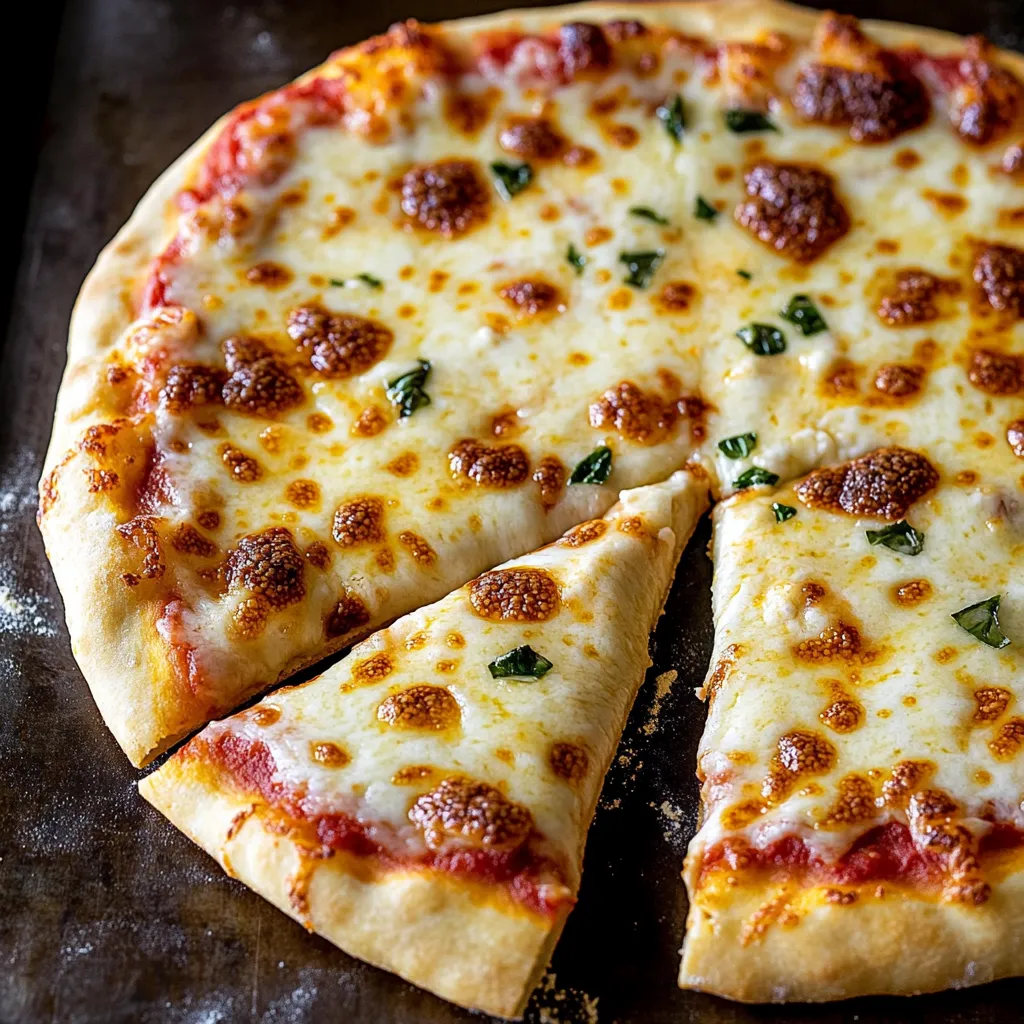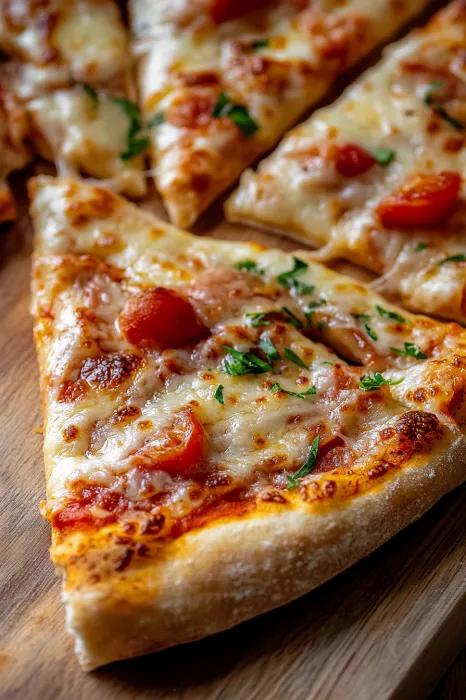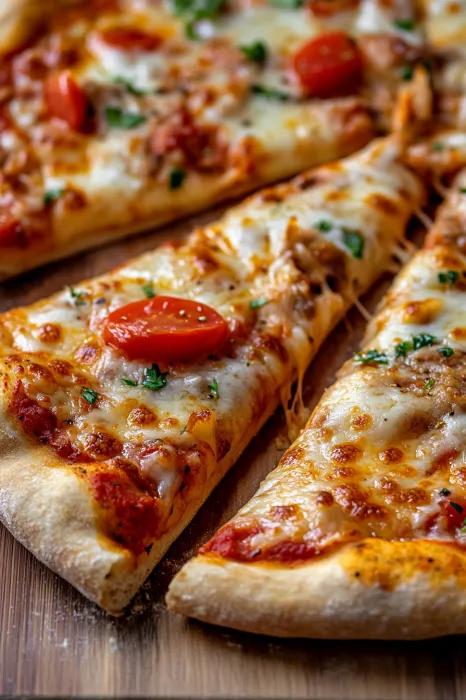 Pin it
Pin it
This overnight pizza dough recipe creates the ultimate New York-style crust with a thin center and beautifully puffed edges. The long fermentation develops complex flavors that make this dough stand out from quick recipes. Each bite offers that perfect balance of crispy exterior and chewy interior that pizza lovers crave.
I discovered this method during my quest to recreate authentic pizzeria taste at home. After dozens of disappointing attempts with quick doughs, this overnight version completely transformed our Friday pizza nights from good to absolutely spectacular.
Ingredients
- Warm water: 105-110°F the precise temperature activates yeast without killing it
- Active dry yeast: just a small amount creates perfect rise through long fermentation
- Honey: provides food for the yeast and adds subtle complexity to the finished crust
- Fine sea salt: enhances flavor and strengthens gluten development
- All purpose flour: creates perfect texture use good quality for best results
- Olive oil: for coating bowls prevents sticking during long refrigeration
Step-by-Step Instructions
- Activate the yeast:
- Combine warm water, honey, and salt in a small bowl, then sprinkle yeast on top. Let it sit for 5 minutes until slightly foamy, which ensures your yeast is alive and ready to work its magic. This gentle activation creates the foundation for perfect fermentation.
- Create the dough:
- Pour the yeast mixture into a well created in your measured flour. Mix until combined, then knead for just 2 minutes. Unlike many doughs, this one requires minimal kneading because the long fermentation will develop gluten naturally. The dough will feel sticky at this point which is exactly what you want.
- First rise:
- Allow the dough to double in size at room temperature for 4-5 hours. This initial fermentation begins developing flavor and creating the gluten structure that gives New York style pizza its characteristic chew. The dough will become noticeably puffy and airy during this stage.
- Fold and shape:
- After the first rise, divide the dough and perform eight gentle folds on each piece. This unique folding technique creates structure without deflating all the precious air bubbles. The goal is to create surface tension while preserving the airy interior of your future crust.
- Overnight fermentation:
- Place each dough ball in a lightly oiled bowl and refrigerate for at least 18 hours. This cold fermentation is where the magic happens. Yeast works slowly, producing complex flavors while the gluten relaxes, making the dough easier to stretch. The texture develops that perfect balance between chewy and tender.
- Bring to room temperature:
- Remove dough from refrigerator one hour before baking. This crucial step allows the dough to relax and warm up, making it much easier to stretch without springing back. The dough should feel pliable and alive in your hands.
- Form the crust:
- Using your knuckles, gently stretch the dough from the center outward. This traditional technique preserves the air bubbles while creating the signature thin center and thicker outer rim. Avoid using a rolling pin which would crush those precious air pockets that create the perfect texture.
- Bake at high heat:
- Slide your topped pizza onto a preheated stone or sheet in a 550°F oven. The extreme heat mimics professional pizza ovens, creating rapid rise, proper browning, and the perfect contrast between crisp exterior and tender interior in just 8-10 minutes.
 Pin it
Pin it
This dough completely changed my homemade pizza game. After years of disappointment, I finally achieved that distinctive chew and flavor I always missed from restaurant pizzas. My favorite moment was watching my Italian neighbor bite into a slice and declare it reminded him of home that validation meant everything.
Storage Solutions
This recipe intentionally makes two dough balls, allowing you to bake one immediately and save the other. The refrigerated dough actually improves over 3-4 days as flavor continues developing. For longer storage, freeze shaped dough balls in individual freezer bags. Thaw overnight in the refrigerator, then follow the standard room temperature rest before shaping.
Perfect Pairings
This New York style crust pairs wonderfully with traditional tomato sauce and whole milk mozzarella. For an elevated experience, try a white pizza with ricotta, mozzarella, and thinly sliced garlic, finished with fresh basil after baking. The robust crust also stands up beautifully to heartier toppings like sausage and peppers without becoming soggy.
Troubleshooting Tips
If your dough feels too sticky during shaping, resist the urge to add much additional flour. A light dusting is sufficient, and excess flour can create a tough crust. The dough should feel alive and slightly tacky. If it springs back excessively during stretching, let it rest covered for 10-15 minutes to relax the gluten, then try again.
The Science Behind Great Pizza
The extended fermentation time creates complex flavor through enzymatic activity that breaks down starches into sugars. Meanwhile, gluten proteins form and relax into the perfect structure. The high baking temperature causes rapid expansion of gas bubbles and caramelization of those newly created sugars, resulting in the characteristic leopard spotting of professional pizza.
 Pin it
Pin it
Frequently Asked Questions
- → Why let the dough rest overnight?
Resting the dough overnight allows gluten to develop, improving texture and enhancing the flavor naturally.
- → Can I use bread or 00 flour instead of all-purpose flour?
Yes, bread or 00 flour works well for this recipe and can provide a slightly different texture to the crust.
- → How do I prevent the dough from sticking?
Lightly dust the dough and work surfaces with flour, and ensure your pizza peel is floured before transferring.
- → Why is preheating the oven important?
A hot oven ensures the crust cooks evenly and crisps up while achieving those puffy edges.
- → Can I freeze the dough for later use?
Yes, you can freeze the dough after the initial rise. Thaw it in the refrigerator overnight before using.
